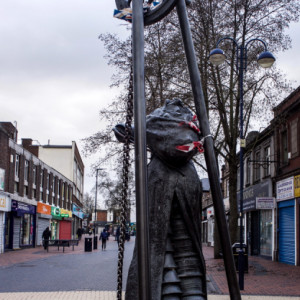Women's Work
I worked for 39 years, the whole of my teaching career, in Bilston in the Black Country, an old industrial area in the West Midlands. We went back today for the second time this week to photograph some sculptures. This is one of them and it took me back through the years to the time when the girls I used to teach had one ambition - to get married (maybe) and have babies. There were very few other ambitions and little motivation to leave Bilston. There was everything they wanted there. Or so it seemed. Looking back now, I realise that we were amongst a community built on steel, and the women were people of steel - they had to be because life was hard and it was this inheritance that was so deeply engrained in the girls that we had to work with. They were not aware of any options. They were firmly ensconced in the traditions of their family and the town. That may seem a little simplistic - it's never that easy is it? But the 1970s were a time of such challenge and change. Bilston borders on to Wolverhampton and Smethwick. The people in the area were changing, there was more cultural diversity, there were racial tensions, the steelworks were being shut down, employment rates were rising, the women had to find work...
This statue brought home to me what life had been like for the women of Bilston. The woman in the statue has a long apron made of tools used at home and in industry. She stands under a pit-head carrying a sack of coal on her back; her arms are made of metalworking tongs; an anvil is her head and her stomach is composed of pulleys. In the extra you can see the cooking pots used to represent her legs. A flat iron has replaced her extended foot. The Pit- head chain is wrapped around her waist showing the tension between the demands of industry and the true nature of woman. She is powerful but stooped, carrying her load - suggesting the heavy burden of poverty and endless hard work needed for the women of Bilston to raise their families.
There are references in the statue to work in the home, but also to coal mining, nail making, chain making - often made in tiny forges attached to the home.
This all pulls on my heart strings - for those women of the past, the girls I taught through the years, the women they have become, the women I see around me. How far have we really come? Not just for the place of women in our society, but thinking about poverty, suffering, lack of opportunity, inequality, injustice.............
All this from one sculpture. And I could go on. What effect did all this have on the men and boys I hear you asking... Well...


Comments
Sign in or get an account to comment.


